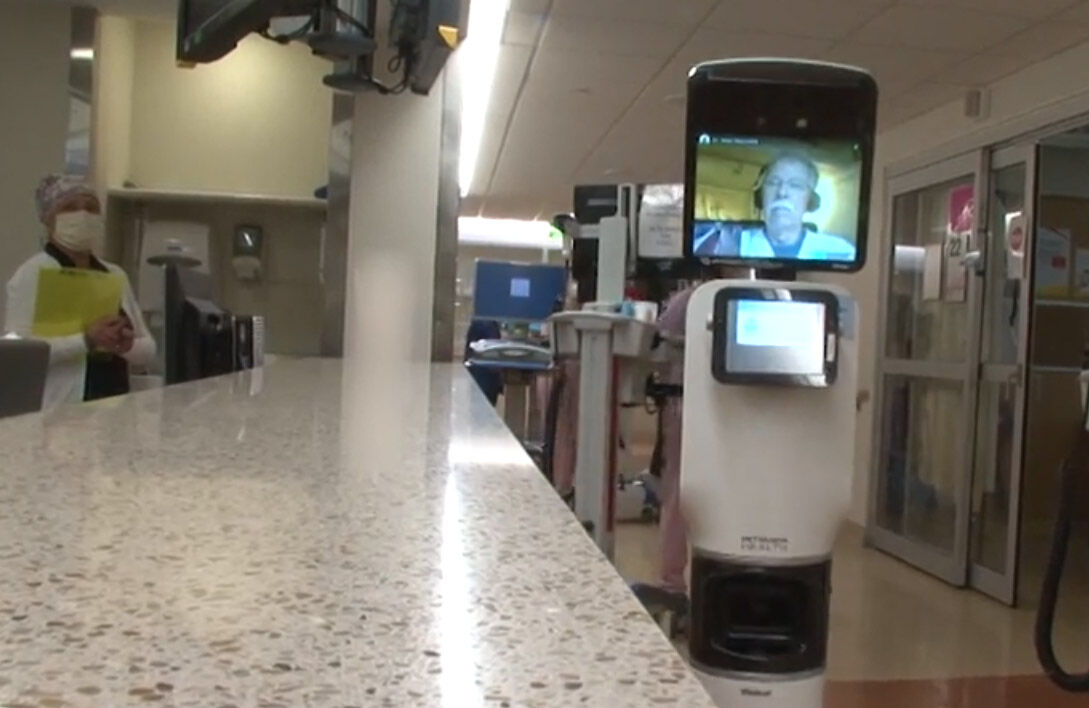
At-risk doctors operating robots on wheels are remotely caring for hospitalized patients, including those infected with COVID-19. A Maryland doctor explains how it works.
“Fast Freddy is the name we gave to one of the robots; he happens to be the robot on my floor,” said Dr. Neal Reynolds, a critical care physician at the University of Maryland School of Medicine.
Reynolds set up the robotic telehealth program when the pandemic hit.
“The robots allow us to get to the bedside virtually without putting the physicians or other health care workers at risk of being infected,” Reynolds said. “We wanted to keep health care workers working if they could.”
The robots are being used as a protective measure by Reynolds, who is over 65 years old, and by pregnant health care workers, those who are in an immunosuppressed state or those who may be self-isolating after testing positive for COVID-19.
From his home 22 miles away, Reynolds is treating patients who are hospitalized at the R Adams Cowley Shock Trauma Center in Baltimore, which has numbers of units devoted to COVID-19 patients in various levels of care.
“This gizmo is sort of pseudo-humanoid. It’s about 5 and 1/2 feet tall; it’s slender, good looking,” he said with a laugh. “And it has a computer screen at the top, which is the face of the operator.”
Reynolds said it is fun being greeted by people who seem surprised when he rolls into the room and introduces himself.
“Patients often smile and maybe even giggle a little bit, and some of them ask me if I’m inside the robot. Sometimes, I tell them I’m not,” Reynolds quipped.
Conversations and examinations occur in real-time, sometimes facilitated by an in-person helper. After a patient visit, Reynolds drives the robot out of the room so he can consult with staff and sub-specialists, such as pharmacists, so they all can develop a plan for care.
Then, Reynolds drives away to his next appointment.
“It’s really like being there, but safe,” Reynolds said.
Robotic health care of this nature became possible about 16 years ago. It’s used worldwide.
“We just haven’t had them recently until this event,” Reynolds said. “It’s been around a good while, but the application in using it for COVID and to protect physicians and health care workers — that’s kind of new.”
Six robots in use throughout the facility are sometimes operated by nurse practitioners and nurses. Robot use may also soon include social workers and case managers planning care for patients for when they are discharged from the hospital.
“We really didn’t want it to be just doctors. Right now, I’m working on bringing in palliative care and pastoral services. Unfortunately, some people do pass away and in cases they request pastoral services quote, ‘at the bedside.’ And this is what we can do,” Reynolds said.
“So, it’s open to essentially anybody with legitimate reasons, and we will license them, and we will train them.”
- Sign up for WTOP alerts
- Latest coronavirus test results in DC, Maryland and Virginia
- Coronavirus FAQ: What you need to know
- Coronavirus resources: Get and give help in DC, Maryland and Virginia
- Bowser: Stay home for Fourth of July amid coronavirus pandemic
- Northam: Virginia still on track to enter Phase 3 despite surges in other states
- Prince George’s Co. to loosen more COVID-19 restrictions Monday
Looking for more information? D.C., Maryland and Virginia are each releasing more data every day. Visit their official sites here: Virginia | Maryland | D.C.








